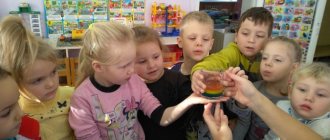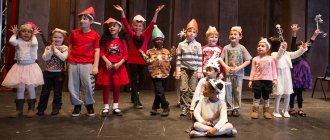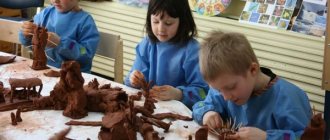The influence of theatrical play on the development of a child’s general abilities
Play in the preschool period is the main activity of children and has a great influence on their mental development (L.S. Vygotsky, A.V. Zaporozhets, A.L. Leontyev, A.A. Lyublinskaya, D.B. Elkonin, etc. ) The term “game” summarizes various manifestations of children’s activities, which differ, first of all, in the nature of the actions and their focus - these are didactic, active, role-playing games, theatrical, musical and others. Thus, theatrical play, as one of the types of play activities, has a significant impact on the course of development of the child’s personality.
The value and peculiarity of theatrical art and its works lies in instant empathy, cognitive, emotional, communicative, vivid impact of the artistic image on the individual (A.V. Zaporozhets, A.A. Leontiev, A.N. Leontiev, Ya.Z. Neverovich) . Therefore, the role of theater in the aesthetic development of preschool children is invaluable, as evidenced by the research of A.M. Vinogradova, S.I. Merzlyakova. In the process of perceiving works of art, children develop a special type of cognition in the form of emotional images (L.I. Bozhovich, A.V. Zaporozhets). On the one hand, they reflect the external image of the surrounding world, on the other hand, the internal component in the form of sensations and ideas gives the emotional image a stimulating, activating character of reflection of the surrounding reality.
At a certain stage of mental development as a result of upbringing in preschool age, as noted by A.V. Zaporozhets, that side of aesthetic perception is revealed, which gives impetus to the development of its cognitive reality. This happens due to the fact that a work of art (visual, musical, literary) not only introduces the child to new phenomena and expands the range of his perception, but also allows him to understand his artistic image. In imaginary relationships, fairy tales, on the basis of which children’s habits and patterns of activity, aspirations and ideals, animal life and the natural world are usually formed.
The aesthetic perception of children, including the perception of theater, is not reduced to passive observation of certain aspects of reality. A preschool child has access to the internal activity of assistance, empathy, and the ability to mentally act in imaginary circumstances (L.S. Vygotsky, A.V. Zaporozhets, etc.). Older preschoolers are also able to understand the inner world of heroes and their contradictory nature. This makes it possible to use drama in the moral education of children, when various norms become significant for the child, correlating not only with a positive, but also with a negative, unattractive character (L.G. Lysyuk, S.G. Yakobson). Thanks to it, social feelings are formed, an emotional attitude to events and actions that are significant not only for the child personally, but also for those around him.
Drama is an extremely emotional activity, which makes it attractive to children. This brings great joy and surprise to the child. It contains the origins of creativity; children accept the guidance of an adult without realizing it. Theatrical activity most fully embraces the child’s personality and corresponds to the peculiarities of the development of his mental processes: Holism and simultaneity of perception, ease of imagination and faith in transformations, emotional sensitivity, not only figurative, but also logical thinking, motor activity, etc. (L.S. Vygotsky, D.B. Elkonin, etc.). This indicates the broad potential for the development of a dramatic play.






